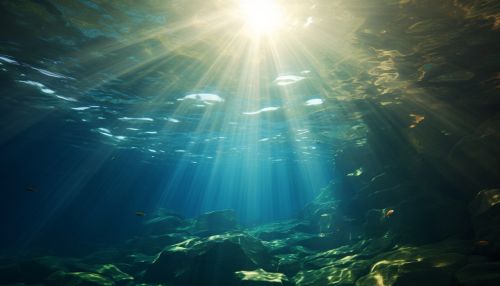Effects of UV Radiation on Aquatic Life
Introduction
Ultraviolet (UV) radiation is a type of electromagnetic radiation that comes from the sun and can have significant effects on aquatic life. UV radiation is divided into three types: UVA, UVB, and UVC, each with different wavelengths and energy levels. The Earth's ozone layer absorbs most of the UVB and all of the UVC radiation, but UVA and a small amount of UVB reach the Earth's surface and can penetrate the surface of bodies of water, affecting the organisms that live there.


Effects on Aquatic Organisms
Aquatic organisms, from the smallest phytoplankton to the largest marine mammals, can be affected by UV radiation. The effects can vary depending on the type and intensity of the UV radiation, the exposure time, and the specific characteristics of the organism.
Effects on Phytoplankton
Phytoplankton, microscopic plants that form the base of the aquatic food chain, are particularly sensitive to UV radiation. Exposure to UVB radiation can inhibit photosynthesis, damage DNA, and impair the growth and reproduction of these organisms. This can have cascading effects on the entire aquatic ecosystem, as phytoplankton are a primary food source for many other organisms.
Effects on Zooplankton
Zooplankton, small animals that feed on phytoplankton, can also be affected by UV radiation. Studies have shown that UVB radiation can cause mortality and sublethal effects in zooplankton, such as reduced feeding and growth rates. Some species of zooplankton have developed adaptive strategies to avoid UV radiation, such as vertical migration to deeper, less UV-exposed waters during the day.
Effects on Fish
Fish can be affected by UV radiation both directly and indirectly. Direct effects can include damage to skin, eyes, and eggs. Indirect effects can result from changes in the food chain. For example, if UV radiation reduces the abundance of phytoplankton and zooplankton, it can lead to a decrease in the food available for fish.
Factors Influencing UV Effects
Several factors can influence the effects of UV radiation on aquatic life. These include water clarity, depth, latitude, altitude, and the presence of dissolved organic matter and other substances that can absorb UV radiation.
Water Clarity
Water clarity can significantly influence the penetration of UV radiation into water bodies. Clearer waters allow more UV radiation to penetrate deeper, potentially affecting a greater number of organisms. Conversely, turbid or murky waters can limit the penetration of UV radiation, providing some protection to aquatic organisms.
Depth
The depth of a water body can also influence the effects of UV radiation. UV radiation decreases with depth, so organisms that live at greater depths are generally less exposed to UV radiation. However, some organisms, such as certain species of fish and zooplankton, may move vertically in the water column and can be exposed to varying levels of UV radiation.
Latitude and Altitude
The intensity of UV radiation varies with latitude and altitude. Higher latitudes and altitudes receive more UV radiation due to the thinner atmosphere and increased angle of the sun's rays.
Dissolved Organic Matter
Dissolved organic matter (DOM) in water can absorb UV radiation and reduce its penetration into water bodies. DOM can originate from various sources, including decaying plant and animal matter, and human activities such as agriculture and wastewater discharge.
Adaptations to UV Radiation
Many aquatic organisms have developed adaptations to cope with UV radiation. These adaptations can include behavioral, physiological, and biochemical strategies.
Behavioral Adaptations
Some aquatic organisms exhibit behavioral adaptations to avoid UV radiation. For example, many species of zooplankton migrate vertically in the water column to avoid UV-exposed surface waters during the day.
Physiological Adaptations
Physiological adaptations to UV radiation can include the development of protective structures, such as thickened skin or scales in fish, and the production of UV-absorbing compounds.
Biochemical Adaptations
Biochemical adaptations can include the production of enzymes that repair UV-induced DNA damage and the synthesis of antioxidants that protect against UV-induced oxidative stress.
Implications for Aquatic Ecosystems
The effects of UV radiation on individual aquatic organisms can have broader implications for aquatic ecosystems. Changes in the abundance and diversity of phytoplankton and zooplankton can affect the structure and function of food webs. Additionally, UV-induced changes in the composition of DOM can influence nutrient cycling and the bioavailability of pollutants.
Human Influences and Future Research
Human activities can influence the effects of UV radiation on aquatic life. For example, pollution can reduce water clarity and increase the penetration of UV radiation into water bodies. Climate change can also influence UV effects by altering factors such as water temperature and ice cover. Future research is needed to better understand these interactions and their implications for aquatic ecosystems.
